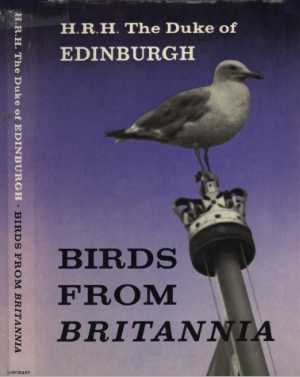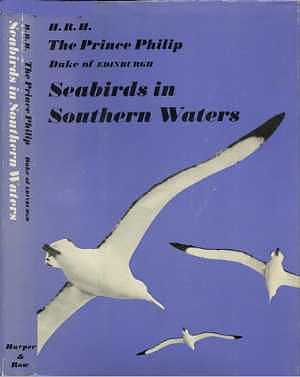  Ebay
2008/01/18 4.95GBP, 2008/01/19 2.99GBP Ebay
2008/01/18 4.95GBP, 2008/01/19 2.99GBP |
| Birds from Britannia published in 1962
by Longmans in Great Britain, and simultaneously published in USA by Harper &
Row as Seabirds in Southern Waters is well known to bird watchers and nature
lovers around the world. Prince Philip's book is an account for two off duty photographic expeditions on the Royal Yacht H.M.Y Britannia, hence the English title "BIRDS FROM BRITANNIA". Expedition 1 began from Kenya to the island paradise Seychelles in Indian Ocean , to Ceylon, Malaya (now Malaysia), Papua New Guinea, Darwin, Alice Spring, to Melbourne, where the photographer Prince joined the 1956 Olympic Games. The expedition continued after the game, from New Zealand to Chatham Island passing date line to Graham Land Peninsular in the Antarctica, onward to Falkland, and a number of isolated islands in the South Atlantic: South Georgia, Gough Island, Tristan da Cunha and ended at St. Helena. The second expedition began from Singapore, through the Strait of Malaca to Couching, Sandakan, Hong Kong, Malaita Island, Ocean Island Vaitupur, Christmas Island through Panama Canal and ended at Bermuda. Prince Philip's book is full of vivid description of the ocean, the sea birds, penguins, seals and wild life, reminiscent of Charles Darwin's Voyage on the Beagle. "The
colour of the sea can vary enormously, the North Sea, for
instance, has a
peculiar greyish-green colour even in fine weather.
The sea off the west
of Scotland has a special black look about it..
The wine-dark seas of
Homer's Mediterranean are again different
from the inky black
of Antarctic and to the much greener blue of the
The book is contain two parts, text and photographs. The text part consists of four sections The Tropical Seas
The Southern Oceans
Sub Antarctic and Antarctic
In closing, Prince Philip wrote : "Although we spent only a few days in the area I can quite understand the fascination which the Antarctic has for many people. It may be bleak and stark, but it has a kind of lonely, empty beauty which exercises a very strong attraction. Graham Land, in particular, with its steep mountains, icefalls and the ever-changing colour of the snow, must have some of the most glorious scenery anywhere in the world. Given half a chance, I would go back, if only to see the penguins and the seabirds again." About the Birds Extensive text accompanying the photographs. Prince Philip's Photo Equipment'sPrince Philip's camera equipment consisted of a Hasselblad with 250mm/f4.0 lens a Minox, a 35mm camera and cine camera. A picture in the books shows the casually
attired photography Prince wearing a pair of Based on the date of the the expedition in 1956-7 and 1959, the Minox camera was probably a Minox IIIs (made between 1954- 1958) All the Minox pictures taken by Prince
Philip were in B&W, the films used were probably ADOX 17, ADOX21, the B&W
film available at that period. Prince Philip's Bird Photography This book is abundantly illustrated
with photographs taken with Hasselblad and Minox A.
are all excellent nature photography taken in natural surroundings. The flying birds pictures were captured with Hasselblad with a long lens, clearly demonstrated the great photographic skill, sharp eyes and quick reflex of the photographer Prince. Prince Philip's Nature Photography with MinoxHubert Heckmann in the book MINOX Variations in 8x11 mentioned Prince Philip used his Minox camera to document for the book Sea Birds in Southern Waters. In 1965, H.R.H. The Prince Philip Duke of Edinburgh accompanied H.M. Queen Elizabeth II on a state visit to Germany. The Prime Minister of Hesse (where Minox GmbH Wetzlar belongs), Georg August Zinn presented a Leicaflex to H.M Queen and a Gold Minox B with engraving of a Royal Crown and the initials P.P to H.R.H. Prince Philip Indeed , Prince Philip wrote in the Introduction : " numbers
51,52,53,54,56,58,59,60,61,62,63, and 66, which I took
|
|
The Longmans edition and the Harper Row edition were probably printed by the same printer. The bulk of the text and photographs are the same. The only difference is in the dust jacket. The Longmans edition has a picture of a bird perching on the flag mast of Yacht Britannia, the Harper edition has picture of three sea birds soaring in the sky. Both pictures were not in side the books. So if you collect both editions you get a complete portfolio.
Both edition were beautifully printed.
Martin Tai Dec 1999